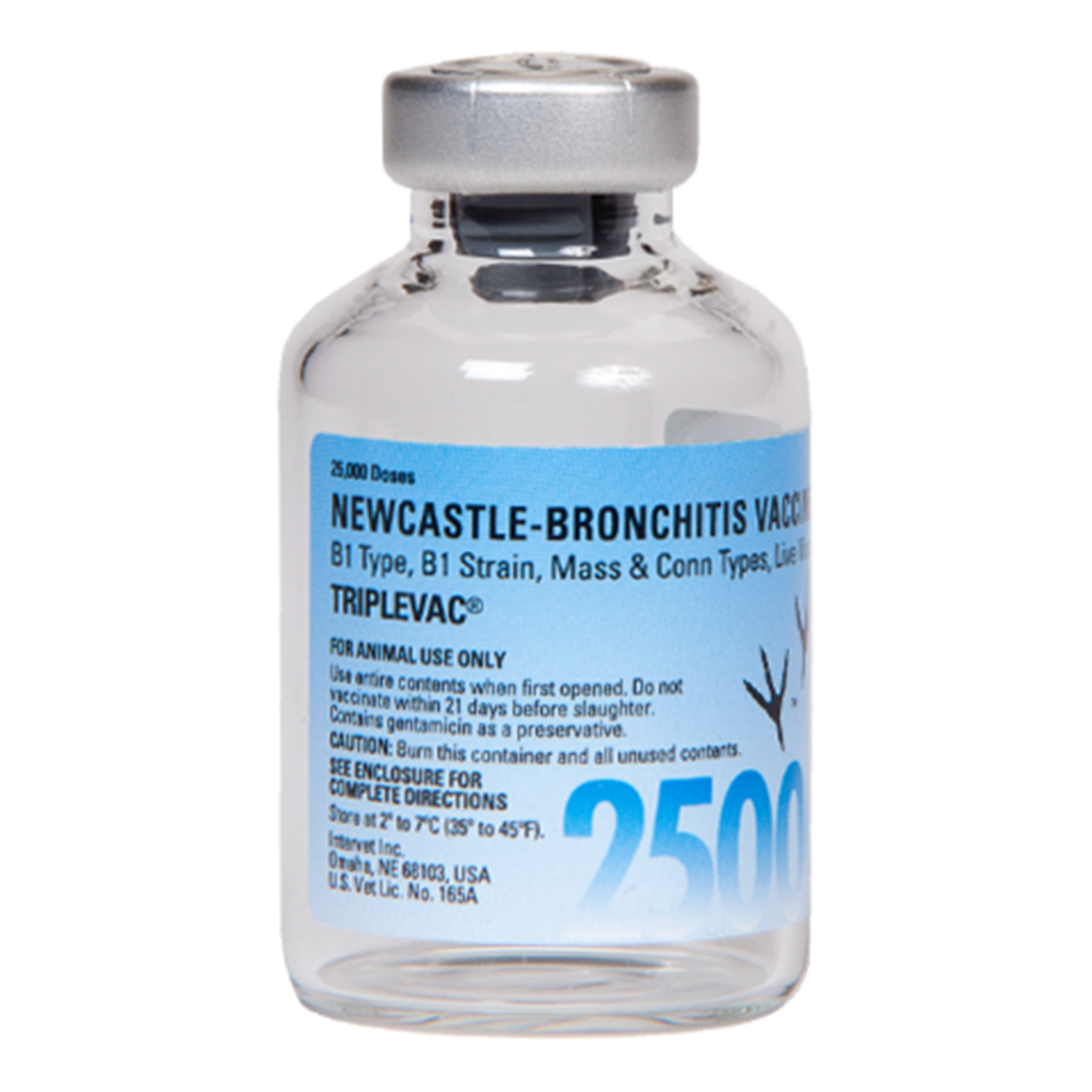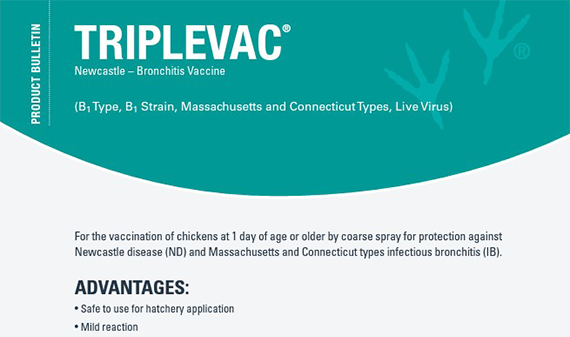TRIPLEVAC®
Newcastle – Bronchitis Vaccine
Product Description
The Triplevac vaccine is prepared from the proven B1 strain of Newcastle disease virus and the mild Massachusetts and Connecticut types of infectious bronchitis virus. The viruses have been propagated using SPF embryonated eggs.


Indications
This product has been shown to be effective for the vaccination of healthy chickens 1 day of age or 2 weeks of age or older against Newcastle disease and infectious bronchitis, Massachusetts and Connecticut types.
Advantages*
- Safe to use for hatchery application
- Mild reaction
- Highly immunogenic protection against ND and broad-spectrum protection against IB
- Excellent immunity when used as a field boost
Diseases/Parasites
- Infectious Bronchitis (IB) – Conn type
- Infectious Bronchitis (IB) – Mass type
- Newcastle disease (ND)
Vaccination Programs
Many factors must be considered in determining the vaccination program for a particular farm or poultry operation. To be fully effective, the vaccine must be administered to healthy receptive birds held in proper environment under good management. In addition, the response may be modified by the age of the birds and their immune status. Seldom does 1 vaccination under field conditions produce complete protection for all individuals in a given flock. The amount of protection required will vary with the type of operation and the degree of exposure that a flock is likely to encounter.
Drinking Water Administration
FOR CHICKENS TWO WEEKS OF AGE OR OLDER
- Do not use any disinfectants in the drinking water for 48 hours before vaccinating and 24 hours after vaccination.
- Withhold the water from the chickens until they are thirsty. Withholding periods will vary from 2 to 8 hours according to age of chickens and weather conditions.
- Scrub waterers and rinse thoroughly with fresh, clean water. Do not use disinfectants for cleaning waterers.
- Mix rehydrated vaccine with clean, cool, non-chlorinated tap water in accordance with the chart on the reverse side.
| Age of Chickens | LITERS | U.S. GAL. |
| 2 – 4 Weeks | 23 | 6 |
| 4 – 8 Weeks | 38 | 10 |
| 8 Weeks or Older | 60 | 16 |
As an aid in preserving the virus, 100 g (3.2 oz.) of non-fat powdered milk may be added to each 38 liters (10 U.S. gal.) of water used for mixing vaccine. Add the dried milk first and agitate thoroughly. Then add the rehydrated vaccine from the vial and mix thoroughly.
- Distribute the vaccine solution, as prepared above, in the waterers provided for the chickens. Avoid placing waterers in direct sunlight.
- Provide no other drinking water until all the vaccine-water solution has been consumed.
Coarse Spray Administration
FOR CHICKENS ONE DAY OF AGE
- Use rehydrated vaccine as indicated for specific coarse spray vaccination machine. For example, a machine which dispenses 20 ml to a box of 100 chickens; – total volume for 2,000 doses in 400 ml, and 10,000 doses is 2,000 ml of deionized water. Mix thoroughly.
- Mix vaccine with clean non-chlorinated water and add the vaccine solution to reservoir on the machine.
- Prime and adjust machine as instructed in manual accompanying the specific machine.
- Place boxes holding 100 chickens each on the conveyor belt or in machine. Activate spray head.
Coarse Spray Administration
FOR CHICKENS TWO DAYS OF AGE OR OLDER
- Initial spray vaccination should be coarse spray.
- Do not use any disinfectants or skim milk in sprayer.
- Use sprayer only for administration of vaccines.
- Shut off all fans while spray vaccinating. Turn on fan immediately after spraying. Be careful in hot weather.
- Spray chickens by walking slowly through the house.
- Follow the manufacturer’s directions regarding water volume.
- Mix vaccine with clean non-chlorinated water.
- Individual(s) spraying chickens should wear face mask and goggles.
Supplied
10 x 25,000 doses
Caution
- VACCINATE ONLY HEALTHY CHICKENS. Although disease may not be evident, coccidiosis, Mycoplasma infection, infectious bursal disease. Marek’s disease, reovirus infection and other disease conditions may cause complications or reduce immunity.
- All susceptible chickens on the same premises should be vaccinated at the same time.
- The revaccination of laying hens with live Newcastle/Bronchitis vaccine may be detrimental to the flock and cannot be generally recommended. Consult your Merck Animal Health representative for more information.
- Efforts should be taken to reduce stress conditions at the time of vaccination and during the post-vaccination period.
- Do not spill or splash the vaccine.
- Do not dilute the vaccine or otherwise stretch the dosage.
- Store at 2° to 8°C (35° to 46°F).
- Use entire contents when first opened.
- Do not vaccinate within 21 days before slaughter.
- Inactivate unused contents before disposal.
- Do not mix with other products, except as specified on this label.
- In case of human exposure, contact a physician.
- This vaccine contains gentamicin as a preservative.
- WARNING: Newcastle virus occasionally causes conjunctivitis in humans. Avoid any contact of vaccine with eyes.
- FOR ANIMAL USE ONLY.
Notice
This vaccine has undergone rigid potency, safety and purity tests, and meets Intervet Inc., U.S. and local regulatory requirements. It is designed to stimulate effective immunity when used as directed, but the user must be advised that the response to the product depends upon many factors, including, but not limited to, conditions of storage and handling by the user, administration of the vaccine, health and responsiveness of the individual chickens, and the degree of field exposure. A safety data sheet (SDS) is available upon request. This and any other consumer information can be obtained by calling Merck Animal Health Customer Service at 1-800-211-3573.
Records
Keep a record of vaccine, quantity, serial number, expiration date, and place of purchase; the date and time of vaccination; the number, age, breed, and locations of chickens; names of operators performing the vaccination and any observed reactions.
Contact our sales or technical services representatives to help design a custom vaccination program.
Resources
For additional information, please see the product label.
For more information regarding efficacy and safety data, go to productdata.aphis.usda.gov.
References
*Data on file, Merck Animal Health

To view our complete product lineup, click to view our
POULTRY PRODUCT CATALOG vol. 3.1.

